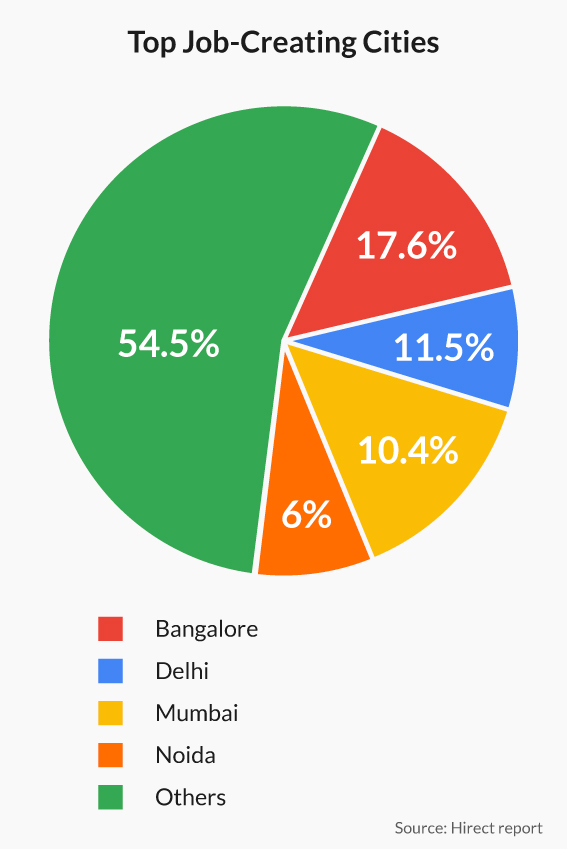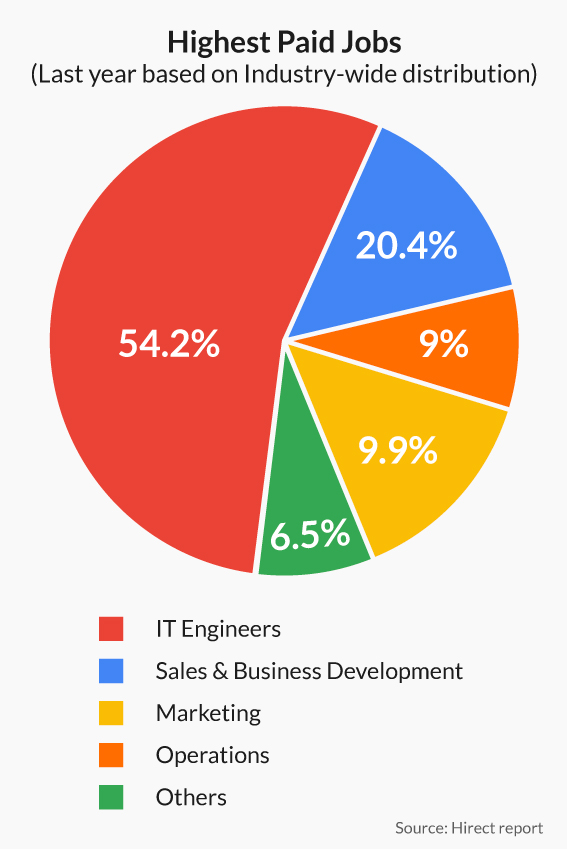There is no denying that India’s hiring and recruitment sector has had its share of crests and troughs. At a time when the Indian start-up ecosystem is witnessing massive layoffs, there is a simultaneous recruiting spree going on as well.
In addition to this, the pandemic has completely revolutionised hiring trends in India. The recruitment processes that seemed to have worked well earlier have proven to not be as successful in current times. The pandemic has also highlighted the recruitment industry’s shortcomings and disparities, with a specific segment of the workforce being disproportionately affected.
According to a report by Hirect, a chat-based, direct hiring platform for start-ups and SMEs, the future of work will not be about degree certificates but skills.
“Following the pandemic, organisations increasingly transformed their hiring policies to highlight that the right skills will be valued over academic credentials. Technology is expected to transform over 1 billion jobs, or nearly one-third of all jobs globally, over the next decade,” the report titled ‘Decoding the Hiring Landscape and Job Market in India’ states.
The report goes on to say that currently, with Gen Z already involved in the workforce and significant millennials in decision making positions, the ‘generalist’ approach has become obsolete. Now hiring teams are very specific in their approach. Let’s find out more about what is trending in India’s job market these days.
Also Read: New guidelines to protect consumers from misleading advertisements
Evolving work culture
Yes, Indian work culture has greatly evolved but it is still a work in progress. However, it does vary from region to region. Barring a few things, there are still a myriad challenges that the working class has to contend with. A common example would be that of the prevalent gender imbalance at the workplaces, which is rampant at every level and in every sector. However, many organisations are actively working towards changing this state of affairs. Meanwhile, technology is expected to transform over 1 billion jobs, or nearly one-third of all jobs globally, over the next decade.
Here are some changes and trends that are being introduced at the workplaces all over the world and which will continue to be followed and propagated in the future.
Diversity in the workforce
Gender inequality at the workplace is still common, particularly in the technical sectors, where a few female workers must contend with an overwhelmingly male workforce. The healthcare sector is at the forefront in the representation of women, with about two-thirds of their entry-level employees and 53 per cent of their senior managers being women.
In June 2020, India’s female labour force participation rate fell, and the two main reasons for this are the facts that their numbers in the workforce are declining and the work that they do in their homes is neither acknowledged nor rewarded.
Employer branding
The relevance of employer branding in attracting, retaining, and engaging top talent cannot be stressed enough. When deciding on where to seek employment, 84 per cent of job seekers consider a company’s reputation as an employer as a very significant factor. The role of organisational culture goes far beyond the workplace environment to affect every aspect of the business, from recruitment to retention to performance. A solid employer brand is likely to attract a more qualified and diverse workforce.
Millennials Vs gen Z
In a start-up environment that promotes a diverse workforce, there is an influx of millennials and Gen Z. While both generations grew up with changing technology, there are some differences in how they approach work and essential tasks. Millennials have witnessed the emergence of various technologies and are likely to be more amiable to racial and gender equality issues.
In contrast, Generation Z is a technologically savvy generation that has never known a time when the internet did not exist. A mutually inclusive workplace of this multigenerational workforce needs to create an excellent working environment filled with empathy, reverse monitoring, diverse collaboration, and more.
Where are the jobs
Even though start-up culture is going through a rough patch with a massive number of employees being given pink slips, the employment scenario in the IT sector remains very robust.
Talking about the highest job creators in the country, the Hirect report reveals that sales and business development accounted for 26.9 per cent of employment. While the IT and the ITeS sector is the second highest employer. The sector hired for 20.6 per cent of the jobs, followed by the marketing sector with 9.9 per cent. Procurement/Trade with 0.3 per cent was one of the least job-creating sectors for the year 2021-22.

“The economy has seen a severe downturn in the past two years, and it has started to show a positive development trajectory. India’s hiring industry has seen quarter-on-quarter growth, with start-ups hiring in significant numbers and creating huge employment opportunities,”
says Raj Das, Global Co-founder & CEO of Hirect India.
In terms of the top employment generating cities, Bangalore ranks number one. The city continues to be in the top position with the highest number of jobs and employment created with a 17.6 per cent share out of the total number of jobs created.
While Delhi grabs the second spot with 11.5 per cent, followed by Mumbai at 10.4 per cent and Noida comes at the tail end with a 6.0 per cent share.

Also Read: India is a bright spot in the global economic arena: WEF
IT engineers get the highest packages
According to the report’s statistics, in the top 20 per cent of the highest paid jobs, IT engineers (with an experience of 5-10 years) are placed among the top with a 54.2 per cent share, followed by sales & business development with a 20.4 per cent share, within the same experience range.

In other words, the average salary in the IT industry for the experience range of 5-10 years is 62.3 per cent higher than the average salary in sales and business development, which is at 20.4 per cent. In the IT/ITES sector, backend technology leads the list with 42.8 per cent of the highest paid jobs. While the web-technology sub-category with a16.2 per cent share comes in at second place.
Also Read: Domestic EV industry to see 10 mn vehicle sales by 2030: Study
Recruitment trends 2022
There has been a drastic development in the hiring process over the past two years, where technology has taken over the various processes. For instance, on-campus recruitments, career fairs and open houses are no longer held on-campus. Video interviews have taken the place of in-person interviews. Job postings have evolved from just job description summaries to a more targeted communication to engage a larger candidate pool in order to stay competitive. Here are some of the main changes that the job market is witnessing.
Decision-makers are actively participating in the hiring process
Rapid alterations in hiring trends have led to recruitment decisions not being confined to just the recruiters and HR. Founders, CXOs, and Directors are actively involved in the hiring process, and this fraternity is highly inclined towards handpicking their teams. The recruiter pool is also expected to grow in the candidate-driven market because of the active participation of the decision makers.
Digitised and automated recruitment processes
The Harvard Business Review reports that the traditional applicant tracking systems (ATS) employ proxy servers to filter candidates by their essential characteristics and reject them if they fail to meet the criteria. This is changing and now employers are using skills-based filters instead of the narrow criteria of an ideal employee to open up the recruitment process. This allows them to garner the candidates who are the best suited and most qualified for the profile that they are hiring for.
Candidate/employee experience
In the era of the all-pervasive social media and the proliferation of employer review sites, candidates’ experiences are crucial in employer branding. Negative reviews can hurt the brand’s reputation in delivering an engaging customer experience. Nowadays, recruiters are advised to communicate with the candidate throughout the hiring process, up until the very end and are being told to clearly explain why the company is not going ahead with their candidacy, if they are not hired. Employers can plan for hiring success in 2022 by incorporating these viable solutions to the pandemic-related problems like hiring automation and candidate shortages.
Also Read: No ads promoting online betting, I&B Ministry to media
Overall, the hiring industry has completely evolved due to rapidly advancing technology and the various adversities that it has had to face in recent times, especially due to the pandemic. Fast, agile, and quick hiring processes, with the emergence of new-age companies, are the “Next New Normal” for the hiring industry. The employer-employee relationship will never be the same again due to the disruptive new recruitment trends, as candidates do not prefer to wait anymore and GenZ has minimum patience for the lengthy hiring process that was the norm for a long time. The sooner the experts and the decision makers adapt to the changing dynamics of the hiring landscape and the job market, the better it will be for their industries and organisations and the economy at large.











